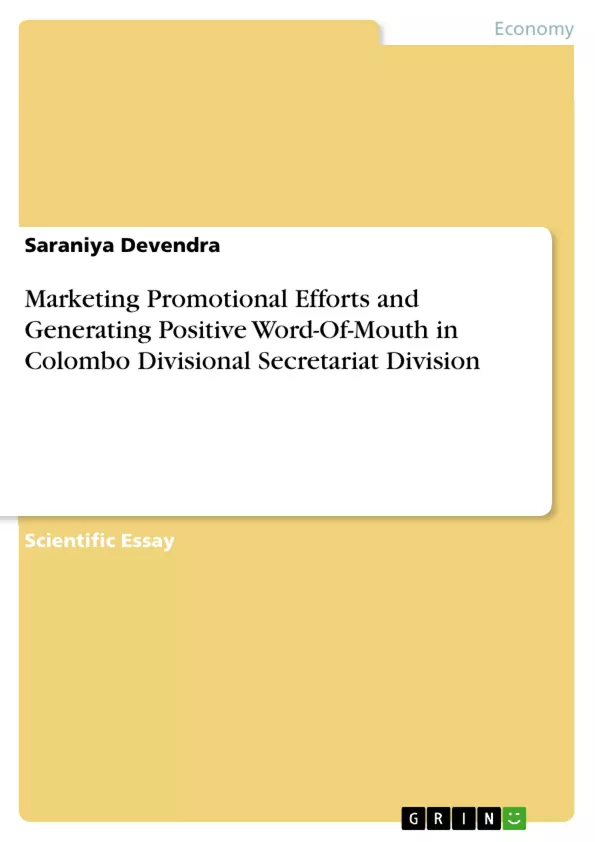Banking industry as a part of service sector in all the world is now in a strong competitive situation. Using Positive Word of Mouth is one of the best tactic to accomplish competitive advantage and to sustain in the market. There is a requirement for generating positive word-of-mouth and an understanding the factors those are influencing on it. Therefore, this research is contributing to identify the main factor that is influencing on Generating Positive Word-Of-Mouth (GPWOM) in relation to banks selectively. To achieve the goal of this research, the data were collected from convenience sample of 200 banking customers in Colombo Divisional Secretariat Division. The respondents provided the data by means of a close-ended questionnaire. Pearson’s Correlation was used for testing the hypotheses. Data analysis was conducted using SPSS Software. The results of this research revealed that Promotional Efforts (PE) has positive significant relationship with GPWOM and PE has higher influence on GPWOM. This study provides outcomes that could be valuable to bank managers for strategic planning and to compete in the industry.
Inhaltsverzeichnis (Table of Contents)
- 1. INTRODUCTION
- 2. PROBLEM STATEMENT AND OBJECTIVES OF THE STUDY
- 3. LITERATURE REVIEW
- 4. METHOD
- 5. RESULTS
- 5.1. Bank Choice
- 5.2. Independent Variable and Its Dimensions
- 5.2.1. Levels of Independent Variable and Its Dimensions
- 5.3. Generating Positive Word-of-Mouth and Its Dimensions
- 5.3.1. Levels of Generating Positive Word-of-Mouth and Its dimensions
- 5.4. The Relationship between PE and GPWOM
- 5.5. Regression of Promotional Efforts (PE) on Generating Positive Word-of-Mouth (GPWOM)
- 6. CONCLUSION, RECOMMENDATION AND IMPLICATION
- REFERENCES
Zielsetzung und Themenschwerpunkte (Objectives and Key Themes)
The main objective of this study is to examine the influence of Promotional Efforts (PE) on Generating Positive Word-of-Mouth (GPWOM) among banking customers in Colombo Divisional Secretariat Division (CDS) in Sri Lanka. This research aims to explore the link between promotional efforts employed by banks and the positive word-of-mouth generated by satisfied customers. The study also seeks to identify the level of PE and GPWOM in relation to selected popular banks in the CDS Division.
- The impact of Promotional Efforts on Generating Positive Word-of-Mouth in the banking industry
- The relationship between specific promotional strategies and customer satisfaction
- The role of word-of-mouth communication in attracting new customers and retaining existing ones
- The competitive landscape of the banking industry in Sri Lanka and the importance of effective marketing strategies
- The significance of positive word-of-mouth as a tool for banks to gain a competitive advantage
Zusammenfassung der Kapitel (Chapter Summaries)
Chapter 1: Introduction This chapter provides an overview of the importance of word-of-mouth communication in the banking industry, particularly in Sri Lanka. It highlights the increasing competition in the banking sector and the need for banks to utilize effective strategies to attract and retain customers. The chapter also emphasizes the potential of positive word-of-mouth as a key marketing tool.
Chapter 2: Problem Statement and Objectives of the Study This chapter identifies the research gap in understanding the influence of Promotional Efforts (PE) on Generating Positive Word-of-Mouth (GPWOM) in Sri Lanka's banking industry. The study aims to investigate this relationship and determine the specific factors that contribute to GPWOM.
Chapter 3: Literature Review This chapter examines existing literature on word-of-mouth communication, promotional efforts, and their impact on customer behavior. It provides a theoretical foundation for the study by exploring various models and frameworks relevant to the research topic.
Chapter 4: Method This chapter details the research methodology employed in the study. It describes the sample selection, data collection methods, and the statistical analysis used to examine the relationship between PE and GPWOM. The chapter also outlines the specific variables and dimensions measured in the study.
Chapter 5: Results This chapter presents the findings of the study. It examines the data collected and analyzes the relationship between promotional efforts and generating positive word-of-mouth. The chapter also discusses the factors that influence GPWOM and their significance for banks.
Schlüsselwörter (Keywords)
The primary focus of this research is on the banking industry in Sri Lanka, specifically examining the influence of Promotional Efforts (PE) on Generating Positive Word-of-Mouth (GPWOM). Key concepts include customer satisfaction, competitive advantage, marketing strategies, service quality, and the role of word-of-mouth communication in driving business success.
- Arbeit zitieren
- Saraniya Devendra (Autor:in), 2019, Marketing Promotional Efforts and Generating Positive Word-Of-Mouth in Colombo Divisional Secretariat Division, München, GRIN Verlag, https://www.grin.com/document/460853



